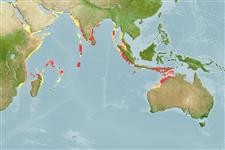>
Ovalentaria/misc (Various families in series Ovalentaria) >
Pomacentridae (Damselfishes) > Chrominae
Etymology: Chromis: Greek, chromis = a fish, perhaps a perch (Ref. 45335); xouthos: Name from Greek 'xouthos' meaning yellowish-brown; refers to the overall coloration..
Environment: milieu / climate zone / depth range / distribution range
Ecología
marino asociado a arrecife; rango de profundidad 12 - 50 m (Ref. 90102). Tropical
Indian Ocean: Maldive Islands and Chagos Archipelago to off the Andaman Sea coast of Thailand; and Indonesia; probably Andaman and Nicobar Islands, and Mergui Archipelago, off Myanmar.
Tamaño / Peso / Age
Maturity: Lm ? range ? - ? cm
Max length : 9.2 cm SL macho / no sexado; (Ref. 75747)
Short description
Morfología | Morfometría
Espinas dorsales (total): 13; Radios blandos dorsales (total): 12; Espinas anales 2; Radios blandos anales: 11 - 12; Vértebra: 26. This species is distinguished by the following characters: DXIII,12; A II,11 (rarely 12); pectoral rays 19 (rarely 18); spiniform caudal rays 3; tubed lateral line scales 16-17; gill rakers 6-7 + 19-21 (total, 26-28); body depth 1.9-2.0 in SL; colour when alive is mainly golden brown with yellowish caudal fin and pale bluish-grey pelvic fins (Ref. 75747).
This species is usually encountered in clear water over coral reefs at depths between about 12 and at least 45 m. Habitats include both gradually sloping bottoms and steeper drop-offs, but in the former case it was restricted to depths greater than 20 m in the vicinity of isolated, small patch reefs. Generally, this species forms aggregations ranging from just a few fish to at least 20-30 individuals, feeding on plankton up to several meters above the bottom. The fish retreat to caves, crevices, and ledges when approached closely by divers (Ref. 75747). Life history characteristics for the family specify that this species is oviparous, with distinct pairing during breeding (Ref. 205). Eggs are demersal and adhere to the substrate (Ref. 205). Males guard and aerate the eggs (Ref. 205).
Life cycle and mating behavior
Madurez | Reproducción | Puesta | Huevos | Fecundidad | Larva
Life history characteristics for the family specify that this group is oviparous, with distinct pairing during breeding (Ref. 205). Eggs are demersal and adhere to the substrate (Ref. 205). Males guard and aerate the eggs (Ref. 205).
Allen, G.R. and M.V. Erdmann, 2005. Chromis xouthos, a new species of damselfish (Pomacentridae) from the East Andaman Sea and Central Indian Ocean. aqua, J. Ichthyol. Aquat. Biol. 10(3):89-94. (Ref. 75747)
IUCN Red List Status (Ref. 130435)
Threat to humans
Harmless
Human uses
Más información
Age/SizeCrecimientoLength-weightLength-lengthLength-frequenciesMorfometríaMorfologíaLarvaDinámica larvariaReclutamientoAbundanciaBRUVS
ReferenciasAcuiculturaPerfil de acuiculturaRazasGenéticaElectrophoresesheritabilidadEnfermedadesProcesamientoNutrientsMass conversion
ColaboradoresImágenesStamps, Coins Misc.SonidosCiguateraVelocidadTipo de nataciónSuperficie branquialOtolitosCerebrosVisión
Herramientas
Special reports
Download XML
Fuentes de Internet
Estimates based on models
Preferred temperature (Ref.
123201): 27.8 - 29, mean 28.4 °C (based on 30 cells).
Phylogenetic diversity index (Ref.
82804): PD
50 = 0.5000 [Uniqueness, from 0.5 = low to 2.0 = high].
Bayesian length-weight: a=0.01778 (0.00796 - 0.03971), b=2.99 (2.81 - 3.17), in cm total length, based on LWR estimates for this Genus-body shape (Ref.
93245).
Nivel trófico (Ref.
69278): 3.0 ±0.1 se; based on size and trophs of closest relatives
Resiliencia (Ref.
120179): Alto, población duplicada en un tiempo mínimo inferior a 15 meses (Preliminary K or Fecundity.).
Fishing Vulnerability (Ref.
59153): Low vulnerability (10 of 100).
